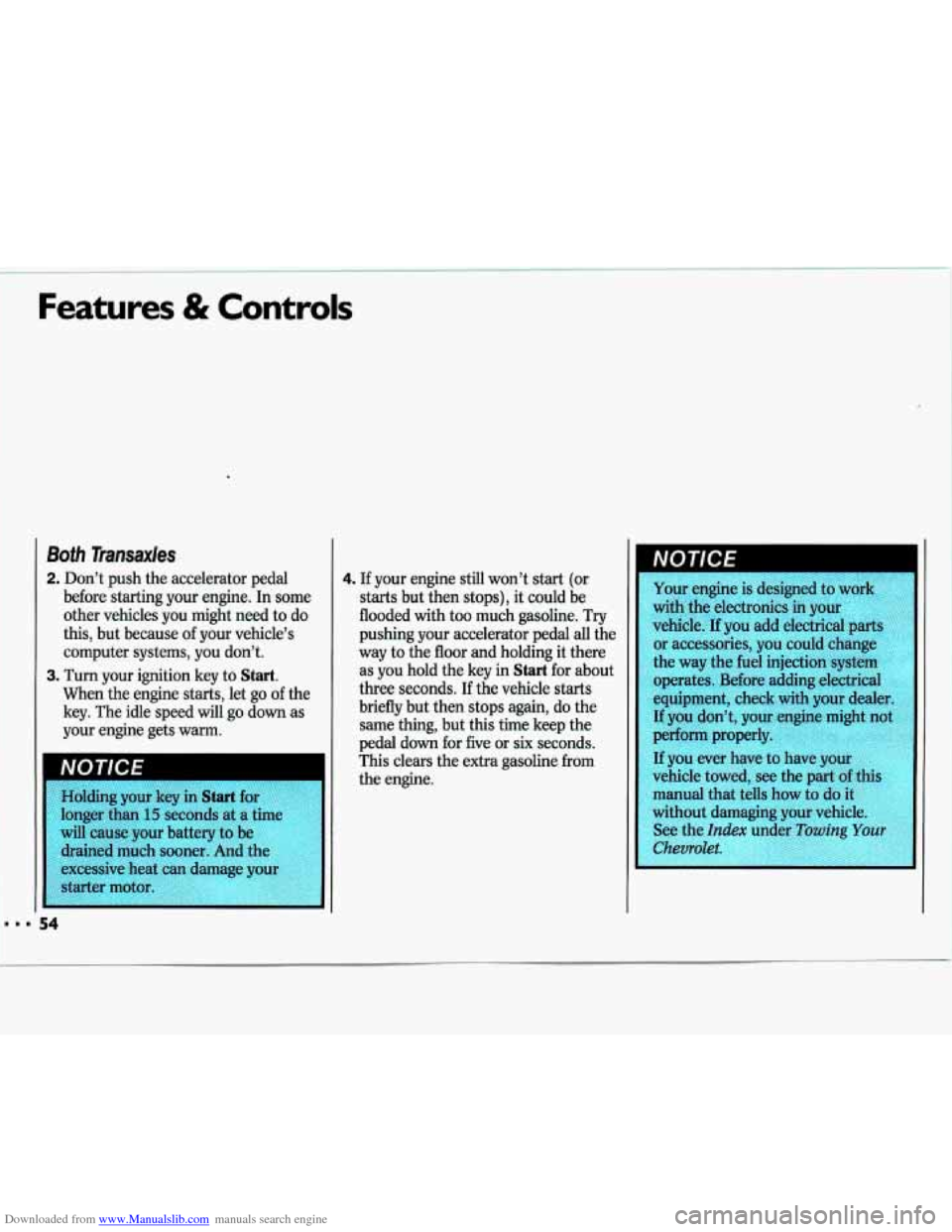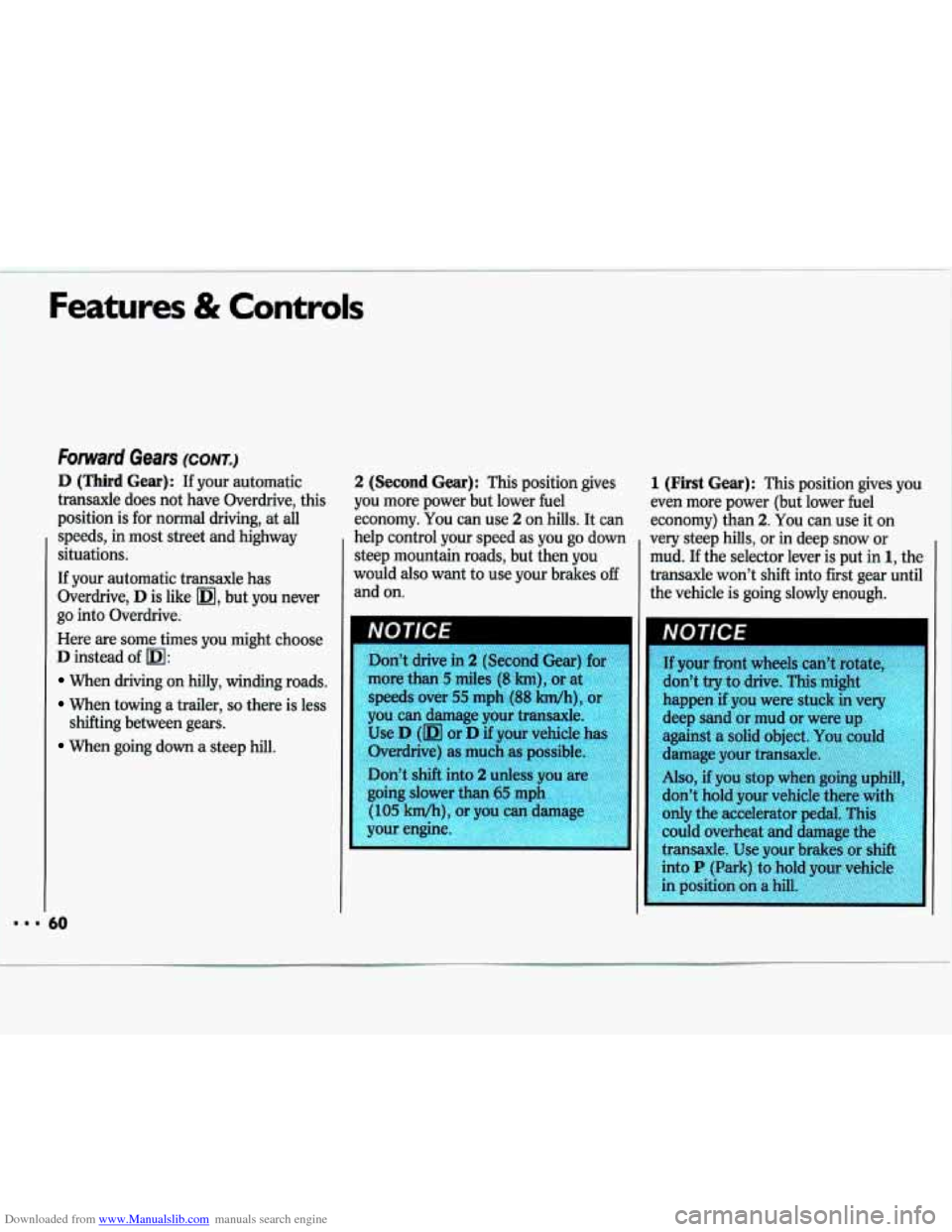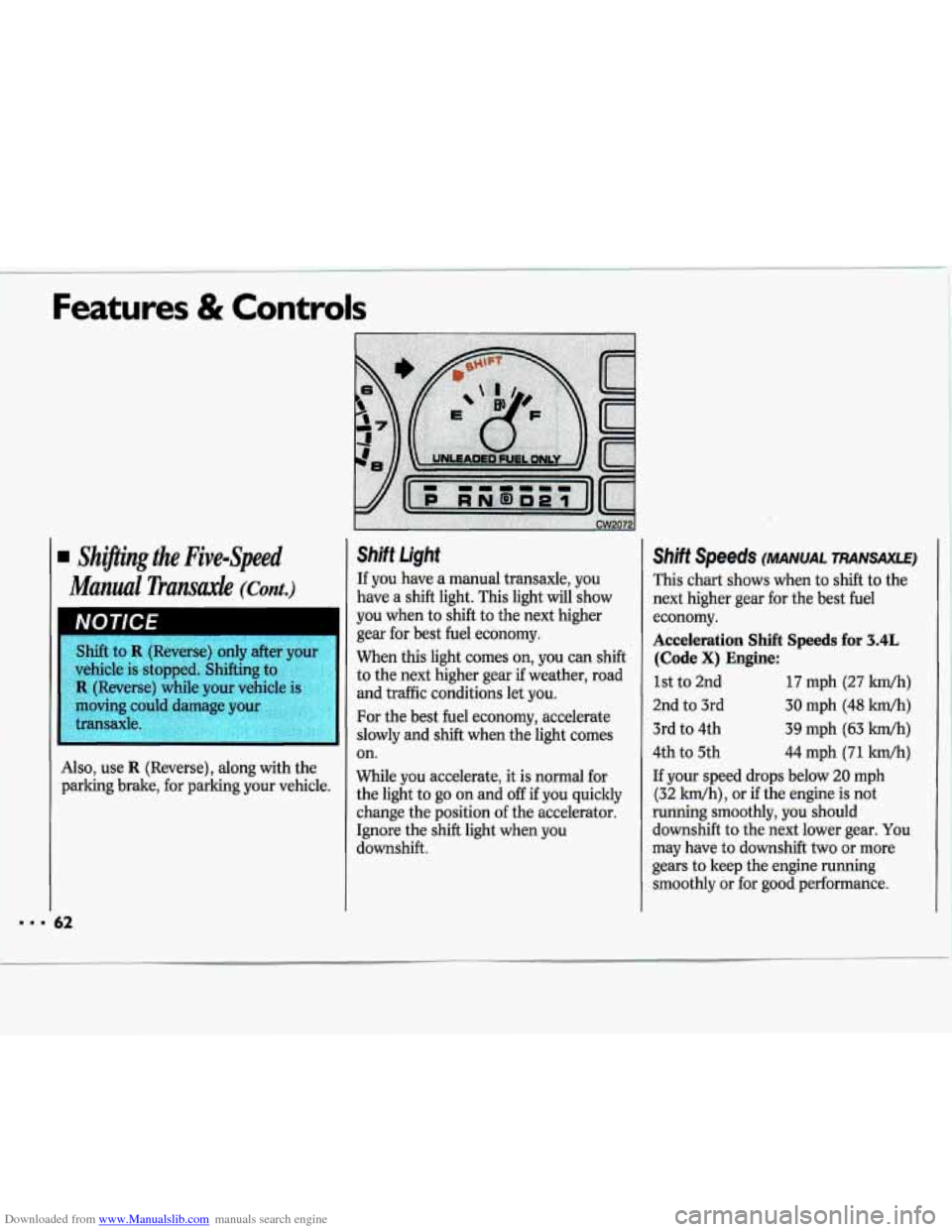Page 56 of 324

Downloaded from www.Manualslib.com manuals search engine Features & Controls
Both Transaxles
2. Don’t push the accelerator pedal
before starting your engine. In some
other vehicles you might need to do
this, but because of your vehicle’s
computer systems, you don’t.
3. Turn your ignition key to Start.
When the engine starts, let go of the
key. The idle speed will go down as
your engine gets warm.
%olding your key in
Start for
longer than
15 seconds at a time
will cause your battery
to be
drained much sooner. And the
excessive heat can damage your
starter motor.
54
4. If your engine still won’t start (or
starts. but then stops), it could be
flooded with too much gasoline.
Try
pushing your accelerator pedal all the
way to the floor and holding it there
as you hold the key in
Start for about
three seconds. If the vehicle starts
briefly but then stops again, do the
same thing, but this time keep the
pedal down for five or
six seconds.
This clears the extra gasoline from
the engine.
I
Your engine is designed to work
with the electronics in your
I
vehicle. If you add electrical parts
or accessories, you could change
the way the fuel injection system
operates. Before adding electrical
equipment, check with your dealer.
If you don’t, your engine might not
perform properly.
If you ever have to have your
vehicle towed, see the part of this
manual that tells how to do it
without damaging your vehicle.
See the
Index under Towing Your
Chevrolet.
Page 57 of 324
Downloaded from www.Manualslib.com manuals search engine )riving Through Deep Standing
Vafer
If you drive too quickly through
deep puddles or standing water
water can come in through you
engine’s air intake and badly
damage your engine.
If you can’,
avoid deep puddles or standing
water, drive through them very
slowly.
c
Engine Block Heater (OPTION)
In very cold weather, 0°F (-18°C) or
colder, the engine block heater can help.
You’ll get easier starting and better fuel
economy during engine warm-up.
To Use the Block Heater:
1. Turn off the engine.
2. Open the hood and unwrap the
3. Plug it into a normal, grounded
electrical cord.
110-volt outlet.
CAUTION
Page 62 of 324

Downloaded from www.Manualslib.com manuals search engine ...
Features & Controls
Forward Gears (CONT.)
D (Third Gear): If your automatic
transaxle does not have Overdrive, this
position is for normal driving, at
all
speeds, in most street and highway
situations.
If your automatic transaxle has
Overdrive,
D is like m, but you never
go into Overdrive.
Here are some times
you might choose
D instead of m:
When driving on hilly, winding roads.
When towing a trailer, so there is less
When going down a steep hill.
shifting between gears.
50
2 (Second Gear): This position
gives
you more power but lower fuel
economy.
You can use 2 on hills. It can
help control your speed
as you go down
steep mountain roads, but then
you
would also want to use your brakes off
and on.
Don’t drive in
2 (Second Gear) for
more than
5 miles (8 km), or at
speeds over
55 mph (88 Mh), or
you can damage your transaxle.
Use
D (m or D if your vehicle has
Overdrive) as much as possible.
Don’t shift into
2 unless you are
going slower than
65 mph
(105 kwh), or you can damage
your engine.
1 (First Gear): This position gives you
even more power (but lower fuel
economy) than
2. You can use it on
very steep hills, or in deep snow
or
mud. If the selector lever is put in 1, the
transaxle won’t shift into first gear until
the vehicle is going slowly enough.
Page 64 of 324

Downloaded from www.Manualslib.com manuals search engine Features & Controls
Shiflng the Five-Speed
Manual Transaxk
(Cant.)
NOTICE
Shift to R (Reverse) only after your
vehicle is stopped. Shifting to
,.
R (Reverse) while your vehicle is 'I
Also, use R (Reverse), along with the
parking brake, for parking your vehicle.
52
Shift Light
If you have a manual transaxle, you
have a shift light. This light will show
you when to shift to the next higher
gear for best fuel economy.
When this light comes on, you can shift
to the next higher gear if weather, road
and traffic conditions let you.
For the best fuel economy, accelerate
slowly and shift when the light comes
on.
While you accelerate, it is normal for
the light to go on and
off if you quickly
change the position of the accelerator.
Ignore the shift light when you
downshift.
Shift Speeds (MANUAL TRANSAXLE)
This chart shows when to shift to the
next higher gear for the best fuel
economy.
Acceleration Shift Speeds for 3.4L
(Code X) Engine:
1st to 2nd 17 mph (27 Wh)
2nd to 3rd 30 mph (48 ldh)
3rd to 4th
39 mph (63 lun/h)
4th to 5th 44 mph (71 ltm/h)
If your speed drops below 20 mph
(32 kwh), or
if the engine is not
running smoothly, you should downshift to the next lower gear. You
may have to downshift two or more
gears to keep the engine running
smoothly or for good performance.
Page 87 of 324
Downloaded from www.Manualslib.com manuals search engine The Instrument Panel-
Your Information System
Your instrument panel is designed to let
you know at
a glance how your vehicle
is running. You’ll know how fast you’re
going, how much. fuel you’re using, and
many other things you’ll need to drive
safely and economically.
The main components
of your
instrument panel are:
1. Vents
2. Turn SignaVHeadlight Beam Lever
3. Tilt Steering Wheel Lever
4. Instrument Cluster
5. Hazard Warning Flashers Switch
6. Vents
7. Climate ControWRear Window
8. Vents
9. Vents Defogger
10. Glove
BodFuse Panel
11. Audio System
12. Gearshift Lever
13. Ashtray and Lighter
14. Ignition Switch
15. Horn
16. Remote Trunk Release (Option)
17. Brake Release
18. Light Controls
19. Hood Release (on floor by driver’s
door)
Page 91 of 324

Downloaded from www.Manualslib.com manuals search engine Tachometer (OPTION)
The tachometer displays the engine
speed in revolutions per minute
(rpm) .
I
engine damage may occur.
Fuel Cage
You have one of the fuel gages shown.
The fuel gage tells you about how much
fuel you have left, when the ignition
is
on. When the indicator nears E (Empty),
you still have a little fuel left, but
you
should get more soon.
Here are three things that some owners
ask about. None of these show a
problem with your fuel gage:
At the gas station, with your ignition
on, the gas pump shuts off before the
gage reads
F (Full).
It takes a little more or less fuel to fill
up than the gage indicated. For
example, the gage may have indicated
the tank was half full, but it actually .
took a little more or less than half the
tank's capacity to fill the tank.
The gage moves a little when you turn '
a corner or speed up.
For your fuel tank capacity,
see Service
Station Information
on the last page of
this manual.
8
U
Page 96 of 324
Downloaded from www.Manualslib.com manuals search engine Features & Controls
Anti-Lock Brake System Warning Light
(CONT.)
is also on, see Brake System Warning
Light
earlier in this section.
If the anti-lock brake system warning
light ever flashes, your anti-lock brake system is still working but needs service
as
soon as possible.
Upshift lndicafor Light
(MANUAL TRANSAXLE)
This light comes on when you need to
shift to the next higher gear. See the
Index under Shift Light.
Malfunction lndicafor Lamp
(Service Engine Soon Light)
A computer monitors operation of your
fuel, ignition and emission control
systems. This light should come
on
when the ignition is on, but the engine
is not running, as a check to show you
it is working. If it does not come on at
all, have it fixed right away. If it stays
on, or it comes
on while you are driving,
the computer is indicating that you
have a problem.
You should take your
vehicle in for service soon.
94
Page 97 of 324
Downloaded from www.Manualslib.com manuals search engine NOTICE
If you keep driving your vehicf ~
with this light on, after awhile LUG
emission controls won’t work OQ
well, your fuel economy won’t vv
as good and your engine may not
run as smoothly. This could lead to